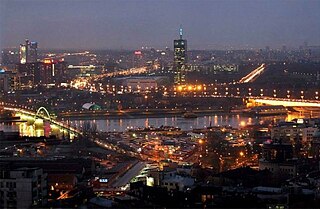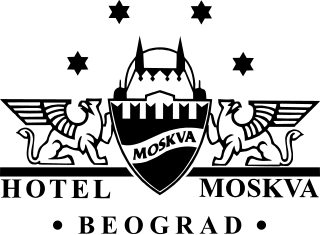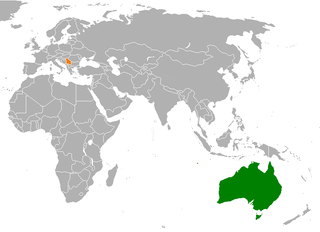
The Beograđanka, officially Belgrade Palace is a modern high-rise building in the Belgrade downtown area.

Bogoljub Karić is a Serbian businessman and politician.

New Belgrade is a municipality of the city of Belgrade. It was a planned city and now is the central business district of Serbia and South East Europe. Construction began in 1948 in a previously uninhabited area on the left bank of the Sava river, opposite old Belgrade. In recent years, it has become the central business district of Belgrade and its fastest developing area, with many businesses moving to the new part of the city, due to more modern infrastructure and larger available space. With 209,763 inhabitants, it is the second most populous municipality of Serbia after Novi Sad.

Used goods, also known as secondhand goods, are any item of personal property offered for sale not as new, including metals in any form except coins that are legal tender, but excluding books, magazines, and postage stamps. Used goods may also be handed down, especially among family or close friends, as a hand-me-down.

The economy of Serbia is a service-based upper-middle income economy in the Central Europe, with the tertiary sector accounting for two-thirds of total gross domestic product (GDP). The economy functions on the principles of the free market. Nominal GDP in 2024 is projected to reach $81.873 billion, which is $12,385 per capita, while GDP based on purchasing power parity (PPP) stood at $185.014 billion, which is $27,985 per capita. The strongest sectors of Serbia's economy are energy, the automotive industry, machinery, mining, and agriculture. The country's primary industrial exports are automobiles, base metals, furniture, food processing, machinery, chemicals, sugar, tires, clothes, and pharmaceuticals. Trade plays a major role in Serbian economic output. The main trading partners are Germany, Italy, Russia, China, and neighbouring Balkan countries.

Sava Centar is an international congress, cultural and business center of various multi-functional activities located in Belgrade, the capital of Serbia. It is the largest audience hall in the country and the entire former Yugoslavia, as well as one of the biggest in Europe. It has hosted numerous large-scale events and performances.

Knez Mihailova Street is the main pedestrian and shopping zone in Belgrade, and is protected by law as one of the oldest and most valuable landmarks of the city. Named after Mihailo Obrenović III, Prince of Serbia, it features a number of buildings and mansions built during the late 1870s.

Hotel Moskva is a four star hotel in Belgrade, one of the oldest currently operating in Serbia. The building has been under governmental protection since 1968. Originally operating as a 36-room inn within the multi-purpose Palace Rossiya, whose almost three-year construction and January 1908 opening represented a major investment of the Russian Empire in the Serbian economy, Hotel Moskva eventually expanded its facilities to take up the entire palace.

Crowne Plaza Belgrade is a four-star hotel located in New Belgrade, Serbia. With its 387 rooms and 29 suites, it is the biggest hotel in the city in terms of capacity.

Fast fashion is the business model of replicating recent catwalk trends and high-fashion designs, mass-producing them at a low cost, and bringing them to retail quickly while demand is at its highest. The term fast fashion is also used generically to describe the products of this business model, particularly clothing and footwear. Retailers who employ the fast fashion strategy include Primark, H&M, Shein, and Zara, all of which have become large multinationals by driving high turnover of inexpensive seasonal and trendy clothing that appeals to fashion-conscious consumers.

Bulevar kralja Aleksandra is the longest street entirely within the urban limits of Serbian capital Belgrade, with length of 7.5 kilometers. Known for decades after World War II as Bulevar Revolucije, it is so distinct in the Belgraders' hearts and minds that they simply refer to it as the Bulevar, although there are 20 boulevards in Belgrade.

Kosančićev Venac is an urban neighborhood of Belgrade, the capital of Serbia. It is located in Belgrade's municipality of Stari Grad. It has been described as the most valuable and most representative veduta of Belgrade. In 1971, it has been declared a spatial cultural-historical unit and placed under legal protection.

Foreign relations exist between Australia and Serbia. The two countries maintained diplomatic relations established by Australia and SFR Yugoslavia in 1966. Australia has an embassy in Belgrade. Serbia has an embassy in Canberra and a general consulate in Sydney. The European office of the Australian Federal Police is located in Belgrade as of 2003.

The BIGZ building is a building located in Belgrade, the capital of Serbia. Designed by Dragiša Brašovan, it is one of the most representative architectural landmarks of Serbian modern architecture. A monumental building, with its position, volume and aesthetics, it dominates the entrance in the southern section of Belgrade. It remained the tallest building in Belgrade for 23 years, until being surpassed by Ušće Tower 1 in 1964.

George Mane Vujnovich was an American intelligence officer for the Office of Strategic Services during World War II. He is known for his role in the organization of Operation Halyard, a successful operation that evacuated over 500 downed Allied airmen from Serbia.
Serbia's automotive industry is one of the most important industrial sectors and makes about 15% of industrial output of the country and 18% of all exports.
Verica Rakočević is a Serbian clothing designer who is known for her high fashion lines and also for manufacturing uniforms for the country's top companies and organizations. She is considered to be Serbia's top designer. She has also gained much power and influence over many areas in Europe's world of fashion, inperticulare magazines and fashion media. In May 2019 Rakočević announced that she will be stepping down as creative director of her company in order to help and mentor her son Nenad's career and his comeback to fashion after he took a few years out due to personal family tragedy and fleeing the country in 2014 after his arrest, spending 88 days in jail. Rakočević published a book about her sons achievements and explaining how the arrest was a politically influenced attack on him and her family. Her son Nenad has been labelled as Europe's next big name in fashion.
Shein is a fast fashion retailer. Founded in Nanjing, China, in October 2008 as ZZKKO by entrepreneur Chris Xu, Shein grew to become the world's largest fashion retailer as of 2022. The company is currently headquartered in Singapore.

Katarina Adanja, was an art historian from Yugoslavia.

Switzerland–Yugoslavia relations were historical foreign relations between Switzerland and now broken up Yugoslavia. Switzerland established diplomatic relations with the Yugoslavia in 1919. A Swiss legation was established in Belgrade in 1940, which was upgraded to an embassy in 1957.

















